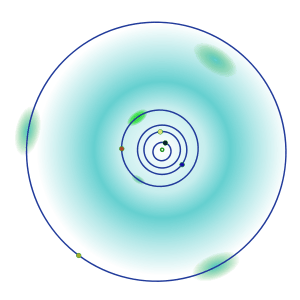(385250) 2001 DH47
| Discovery | |
|---|---|
| Discovered by | Spacewatch |
| Discovery date | 20 February 2001 |
| Designations | |
| MPC designation | 2001 DH47 |
Martian L5  | |
| Orbital characteristics[1] | |
| Epoch 13 January 2016 (JD 2457400.5) | |
| Uncertainty parameter 0 | |
| Observation arc | 5521 days (15.12 yr) |
| Aphelion | 1.5767436 AU (235.87749 Gm) |
| Perihelion | 1.4708966 AU (220.04300 Gm) |
| 1.5238201 AU (227.96024 Gm) | |
| Eccentricity | 0.0347308 |
| 1.88 yr (687.07 d) | |
| 322.37107° | |
| 0° 31m 26.279s / day | |
| Inclination | 24.40220° |
| 147.42225° | |
| 17.54935° | |
| Earth MOID | 0.484635 AU (72.5004 Gm) |
| Jupiter MOID | 3.42254 AU (512.005 Gm) |
| Jupiter Tisserand parameter | 4.400 |
| Physical characteristics | |
| Dimensions | 562 m |
| 0.5–0.05 (assumed) | |
| 18.9 | |
|
| |
(385250) 2001 DH47, also written as 2001 DH47, is a small asteroid orbiting near the L5 point of Mars (60 degrees behind Mars on its orbit).[2][3]
Discovery, orbit and physical properties
2001 DH47 was discovered on February 1, 2001 by the Spacewatch program, observing from Steward Observatory, Kitt Peak[4] and classified as Mars-crosser by the Minor Planet Center. Its orbit is characterized by low eccentricity (0.035), moderate inclination (24.4º) and a semi-major axis of 1.52 AU.[4] Its orbit is well determined as it is currently (March 2013) based on 45 observations with a data-arc span of 3,148 days.[1] It has an absolute magnitude of 19.7 which gives a characteristic diameter of 562 m.[1]
Mars trojan and orbital evolution
It was identified as Mars trojan by H. Scholl, F. Marzari and P. Tricarico in 2005 and its dynamical half-lifetime was found to be of the order of the age of the Solar System.[2] Recent calculations [3] confirm that it is indeed a stable L5 Mars trojan with a libration period of 1365 yr and an amplitude of 11°. These values as well as its short-term orbital evolution are very similar to those of 5261 Eureka.
Origin
Long-term numerical integrations show that its orbit is very stable on Gyr time-scales (1 Gyr = 1 billion years).[2][3] As in the case of Eureka, calculations in both directions of time (4.5 Gyr into the past and 4.5 Gyr into the future) indicate that 2001 DH47 may be a primordial object, perhaps a survivor of the planetesimal population that formed in the terrestrial planets region early in the history of the Solar System.[3]
See also
References
- 1 2 3 "385250 (2001 DH47)". JPL Small-Body Database. NASA/Jet Propulsion Laboratory. Retrieved 12 April 2016.
- 1 2 3 Dynamics of Mars Trojans
- 1 2 3 4 de la Fuente Marcos, C.; de la Fuente Marcos, R. (April 2013). "Three new stable L5 Mars Trojans". Monthly Notices of the Royal Astronomical Society: Letters. 432 (1): L31–L35. arXiv:1303.0124
 . Bibcode:2013MNRAS.432L..31D. doi:10.1093/mnrasl/slt028.
. Bibcode:2013MNRAS.432L..31D. doi:10.1093/mnrasl/slt028. - 1 2 MPC data on 2001 DH47
Further reading
- 2001 DH47 Ivashchenko, Y., Ostafijchuk, P., Spahr, T. B. 2007, Minor Planet Electronic Circular, 2007-P09.
- Dynamics of Mars Trojans Scholl, H., Marzari, F., Tricarico, P. 2005, Icarus, Volume 175, Issue 2, p. 397–408.
- Three new stable L5 Mars Trojans de la Fuente Marcos, C., de la Fuente Marcos, R. 2013, Monthly Notices of the Royal Astronomical Society: Letters, Vol. 432, Issue 1, pp. 31–35.
External links
- 2001 DH47 data at MPC
- 2001 DH47 data at AstDyS-2.
- (385250) 2001 DH47 at the JPL Small-Body Database